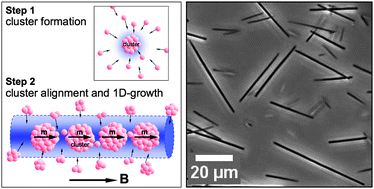Growth mechanism of nanostructured superparamagnetic rods obtained by electrostatic co-assembly†
Abstract
We report on the

* Corresponding authors
a
Matière et Systèmes Complexes, UMR 7057 CNRS Université Denis Diderot Paris-VII, Bâtiment Condorcet, 10 rue Alice Domon et Léonie Duquet, Paris, France
E-mail:
jean-francois.berret@univ-paris-diderot.fr
b UPMC Paris VI–Laboratoire de Physico-chimie des Electrolytes, Colloïdes et Sciences Analytiques UMR 7195 CNRS, 4 place Jussieu, Paris Cedex 05, France
We report on the

 Please wait while we load your content...
Something went wrong. Try again?
Please wait while we load your content...
Something went wrong. Try again?
M. Yan, J. Fresnais and J.-F. Berret, Soft Matter, 2010, 6, 1997 DOI: 10.1039/B919992F
To request permission to reproduce material from this article, please go to the Copyright Clearance Center request page.
If you are an author contributing to an RSC publication, you do not need to request permission provided correct acknowledgement is given.
If you are the author of this article, you do not need to request permission to reproduce figures and diagrams provided correct acknowledgement is given. If you want to reproduce the whole article in a third-party publication (excluding your thesis/dissertation for which permission is not required) please go to the Copyright Clearance Center request page.
Read more about how to correctly acknowledge RSC content.
 Fetching data from CrossRef.
Fetching data from CrossRef.
This may take some time to load.
Loading related content
